Din-i-ilahi:
Din-i Ilahi, also known as the "Religion of God," was a syncretic religious movement initiated by the Mughal Emperor Akbar in the late 16th century. Akbar, known for his policy of religious tolerance and efforts to integrate diverse religious communities, sought to create a unifying faith that could bridge the gaps between different religious communities in his empire.
 |
| Din-i-ilahi |
Key features of Din-i Ilahi:
1. Syncretic Nature:
Din-i Ilahi aimed to blend elements from various religions existing in the Mughal Empire, including Hinduism, Islam, Zoroastrianism, Christianity, and Jainism. It was an attempt to create a universal religion that could promote unity among the diverse subjects of the empire.
2. Incorporation of Beliefs:
The religion incorporated elements from different belief systems, such as the belief in one God, ethical principles, rejection of idol worship, and the promotion of virtues like truthfulness, kindness, and justice.
3. Spiritual Gatherings:
Akbar held spiritual gatherings known as "Ibadat Khana" or "House of Worship" where scholars and religious leaders from various traditions would engage in discussions on religious and philosophical matters.
4. Notable Followers:
Some prominent figures in Akbar's court, including his finance minister Raja Todar Mal and Birbal, were believed to have embraced Din-i Ilahi. However, the movement did not gain widespread acceptance, and it remained a personal philosophy of Akbar.
5. Lack of Mass Following:
Despite Akbar's efforts, Din-i Ilahi did not attract a large following. The majority of the population continued to practice their respective religions, and the movement did not become a lasting religious force.
6. Criticism:
Din-i Ilahi faced criticism from various quarters, including orthodox religious leaders who viewed it as a departure from traditional beliefs. Some saw it as an attempt by Akbar to undermine existing religious institutions.
7. Limited Duration:
The movement was relatively short-lived and did not survive beyond Akbar's reign. After his death in 1605, subsequent rulers did not actively promote Din-i Ilahi, and it gradually faded away.
Despite its limited impact, Din-i Ilahi remains a significant chapter in the history of religious tolerance and cultural synthesis during the Mughal era in India. Akbar's efforts to promote harmony and understanding among different religious communities left a lasting legacy in the region.